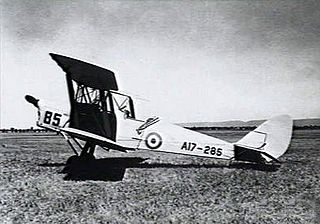- No. 1 Initial Flying Training School RAAF
-
No. 1 Initial Flying Training School 
RAAF De Havilland Tiger MothActive 1951–1955 Allegiance  Australia
AustraliaBranch  Royal Australian Air Force
Royal Australian Air ForceRole Initial flying training Garrison/HQ RAAF Station Archerfield No. 1 Initial Flying Training School (No. 1 IFTS) was a flying training school of the Royal Australian Air Force (RAAF). It was formed in 1951 in response to increased demand for aircrew during the Korean War and Malayan Emergency. Established at RAAF Station Archerfield, Queensland, and operating De Havilland Tiger Moths, the unit was merged with No. 1 Basic Flying Training School at RAAF Base Uranquinty, New South Wales, in 1955.
History
Prior to World War II, all pilot training in the Royal Australian Air Force (RAAF) was conducted under the auspices of one unit, No. 1 Flying Training School (No. 1 FTS), at RAAF Point Cook, Victoria. With the dramatic expansion of aircrew training under the wartime Empire Air Training Scheme, No. 1 FTS was supplanted in 1940–41 by twelve Elementary Flying Training Schools (EFTS) and eight Service Flying Training Schools (SFTS).[1][2] Post-war rationalisation saw all the EFTSs and SFTSs disbanded. No. 1 FTS, re-formed using the personnel and equipment of No. 5 Service Flying Training School in Uranquinty, New South Wales, returned to Point Cook and again became the RAAF's sole facility for training new pilots.[3][4]
In response to demands for more aircrew to fulfil Australia's commitments to the Korean War and Malayan Emergency, flying training in the RAAF was again expanded in 1951–52, with the functions of No. 1 FTS being split among three separately located units.[5] On 28 November 1951, No. 1 Initial Training School (No. 1 ITS) was raised at RAAF Station Archerfield, Queensland, to impart students with general aeronautical and military knowledge, after which they received their flight grading during twelve hours on De Havilland Tiger Moths. Graduate pilots of No. 1 ITS went on to another new unit, No. 1 Basic Flying Training School (No. 1 BFTS) at RAAF Base Uranquinty, New South Wales, where they underwent further aerial instruction that included instrument, formation and night flying on Tiger Moths and CAC Wirraways. Successful students finally transferred to No. 1 FTS, which was renamed No. 1 Applied Flying Training School in March 1952, for advanced weapons and combat training on Wirraways, before graduating as Sergeant Pilots.[6][7]
No. 1 ITS's Tiger Moths began arriving at Archerfield on 4 January 1952, and the first course commenced two days later. It graduated on 27 March, having flown a total of some 1,000 hours. The unit was renamed No. 1 Initial Flying Training School on 28 May. As well as RAAF pilots, the school trained students from the Royal Australian Navy's Fleet Air Arm, and gave Air Training Corps cadets flying experience. Six of its Tiger Moths went on a recruiting drive around Kingaroy and Bundaberg in August 1952, the same month that its first graduates commenced the next phase of their training at No. 1 BFTS.[7][8] Those students selected to be navigators rather than pilots went on to the School of Air Navigation at RAAF Base East Sale, Victoria.[6] In April 1954, the Tiger Moths practised bombing and strafing troops in an exercise with the Australian Army's 9th Batallion.[7] By November 1954, the RAAF's need for further aircrew to meet its international obligations had eased and the decision was made to combine the syllabus of No. 1 IFTS with No. 1 BFTS starting in the new year. No. 1 IFTS was disbanded on 24 January 1955, and the base handed over to No. 23 Squadron.[6][7]
Notes
- ^ Stephens, The Royal Australian Air Force, pp. 67–70
- ^ Gillison, Royal Australian Air Force 1939–1942, p. 111
- ^ RAAF Historical Section, Units of the Royal Australian Air Force, pp. 38–39
- ^ Stephens, Going Solo, pp. 145–146
- ^ Stephens, Going Solo, p. 149
- ^ a b c Stephens, The Royal Australian Air Force, pp. 199–200
- ^ a b c d RAAF Historical Section, Units of the Royal Australian Air Force, p. 43
- ^ Ilbery, Hatching an Air Force, pp. 121–129
References
- Gillison, Douglas (1962). Australia in the War of 1939–1945: Series Three (Air) Volume I – Royal Australian Air Force 1939–1942. Canberra: Australian War Memorial. OCLC 2000369. http://www.awm.gov.au/histories/second_world_war/volume.asp?levelID=67912.
- Ilbery, Peter (2002). Hatching an Air Force: 2 SFTS, 5 SFTS, 1 BFTS Uranquinty and Wagga-Wagga. Maryborough, Queensland: Banner Books. ISBN 1875593241.
- RAAF Historical Section (1995). Units of the Royal Australian Air Force: A Concise History. Volume 8: Training Units. Canberra: Aust. Govt. Pub. Service. ISBN 0644428007.
- Stephens, Alan (1995). Going Solo: The Royal Australian Air Force 1946–1971. Canberra: Aust. Govt. Pub. Service. ISBN 0644428031.
- Stephens, Alan (2006) [2001]. The Royal Australian Air Force: A History. London: Oxford University Press. ISBN 0195555414.
Categories:- RAAF training units
- Military units and formations established in 1951
- Military units and formations disestablished in 1955
Wikimedia Foundation. 2010.
